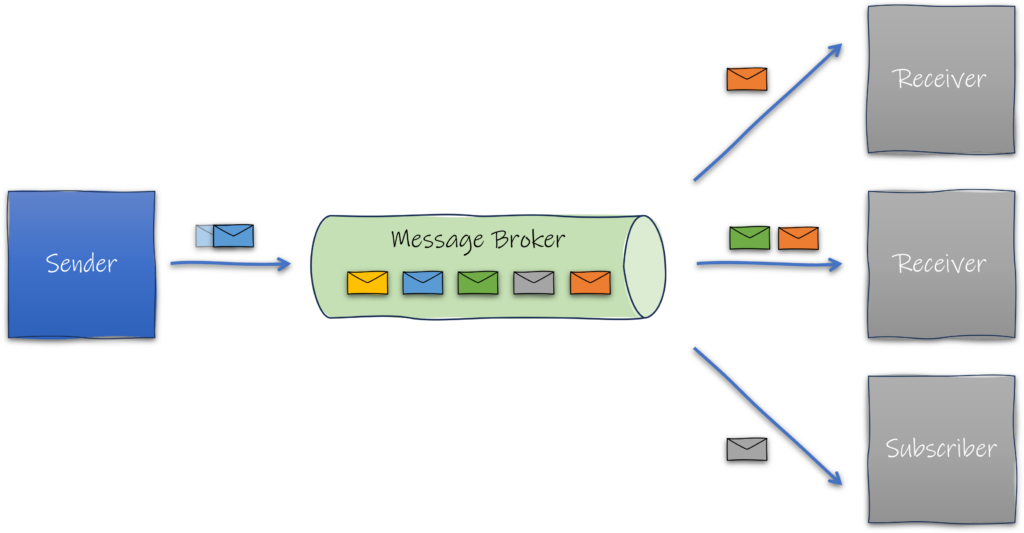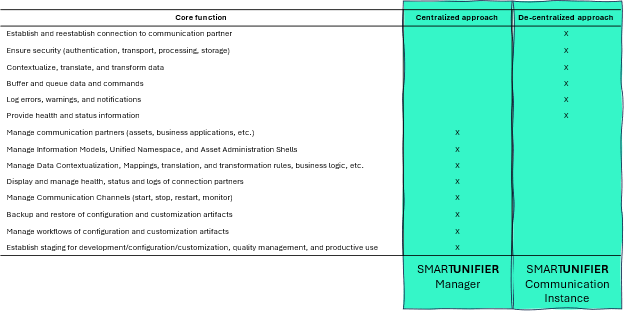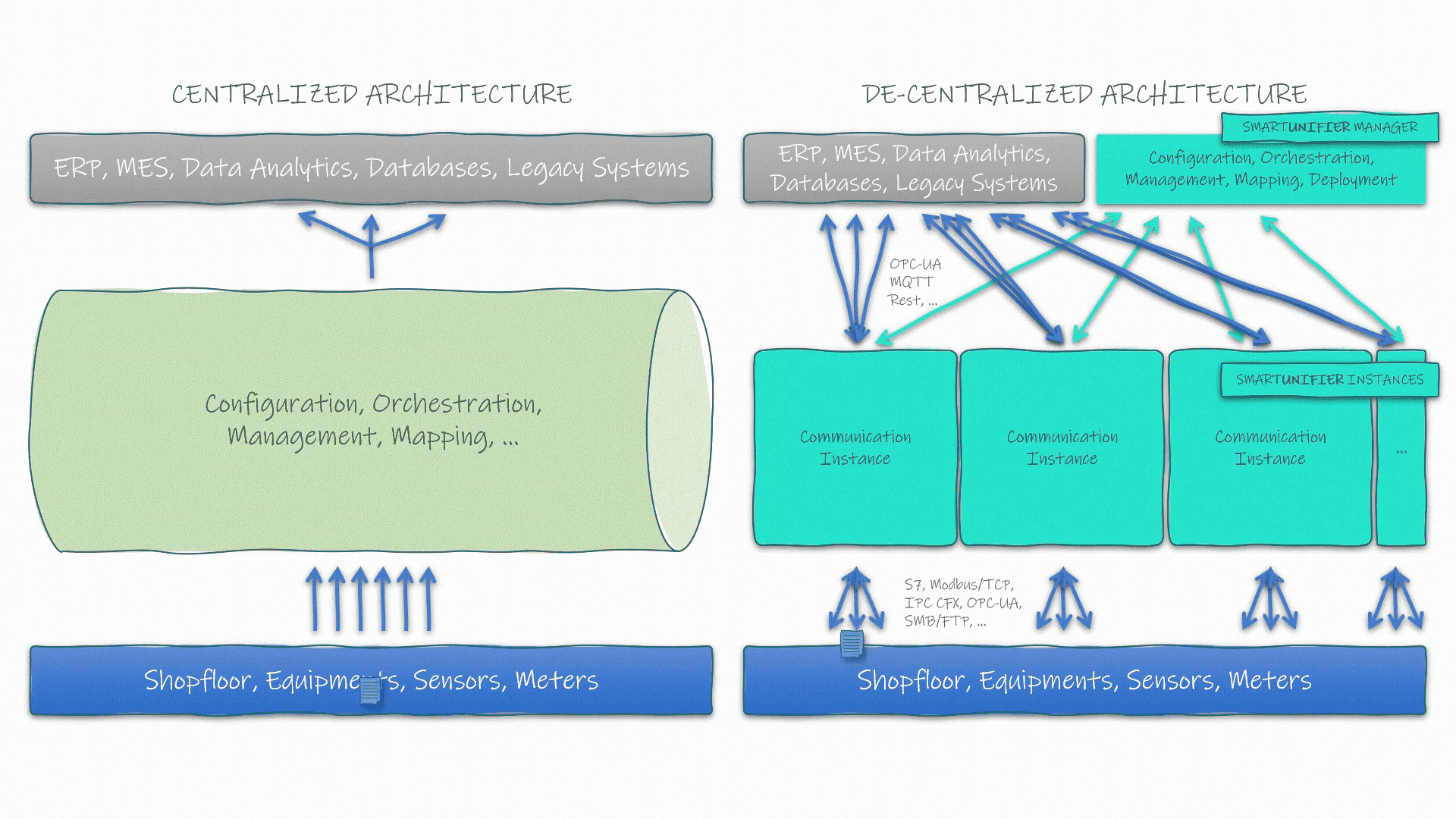Message Brokers and SMARTUNIFIER

This is a schema of a Message Broker. Using it for Industrial Data Connectivity seems to be an unwritten law. Some would call it ‘low-brainer’ because the centralization of shopfloor equipment data appears to be as natural as it can be. Further concepts and approaches like Asset Administration Shell, Unified Namespace, or Digital Twin look as if they were supporting or even requiring this approach.

Is it because it is good and efficient? Because it solves all problems of IIoT connectivity? Because there is no other solution? Certainly not. In most cases, it is because a Message Broker is an already existing software component, that cost and still costs a lot of money. Business economists are calling this Investment Protection.
Advantages of a centralized data connectivity architecture
There are multiple explanations web-wide, which describe very well how a centralized architecture such as a Message Broker works. To keep it short and crisp: Data from different sources are being sent to a centralized software component. Data conversions, consolidations, transformations, security functions, and protocol conversions are being performed, and, after this, the collected data is being distributed to target systems (like MES) or databases.
The simple aspect of this approach is that the Message Broker is deployed on a server and can therefore be administered and configured centrally. However, it is a misconception, that you need to follow a centralized IT architecture to do this efficiently.
In this context, it is crucial to understand the difference between a centralized IT Architecture and a centralized Enterprise Architecture. While centralized IT means single-instance deployment (redundant systems to provide higher availability not counted) of (virtual) hardware and software, centralized Enterprise Architecture on the other hand means a central provision of concepts and data governance. See the difference?
Differences to a decentralized architecture
Let us do an exercise on how core functions of a data connectivity solution could be de-centralized.

This subset function list is an example of a combined centralized and de-centralized functional architecture, which is implemented in SMARTUNIFIER. All functionality, such as the management of Information Models (e.g. Unified Namespace, Asset Administration Shell, Digital Twin), which is part of an Enterprise Architecture, is centralized and should be. All other functionality concerning connection and data handling is performed within a de-centralized, wherever deployed, Communication Instance.
But why? What is the key advantage of de-centralizing these functions? It all comes down to performance, availability, stability, and finally scalability. Connections to communication partners need to be stable, ideally for months and years without any interruption and loss of data. Set it and forget it!
A decentralized architecture does not care about how many Communication Channels are being configured, and how many assets are communicating to how many business applications. Leave the bottlenecks to where they always have been, namely to the data sources, data targets, and network components, and not to the connectivity solution.
Downsides of a centralized architecture
The picture at the top of this blog is only half of the truth. To add slightly more realism to this approach, let us add only one detail.

There is not a single data source, there are multiple. Adding this to the picture makes something really obvious: Make no mistake, each Message Broker is a single point of failure and, in addition to that, a bottleneck, nicely positioned between the data sources and the upper-level systems (receivers). Sure, crucial functionalities of a Message Broker are implemented to prevent data from being lost and to enable data to be transferred asynchronously. This and all reconnection, mapping, protocol conversion, and more logic blows it up into a humongous, resource-consuming, and expensive piece of business application. Immediately, an IT architect thinks of load balancing and redundancy – resulting in additional lines in his or her CAPEX planning sheet.
Now, let us place the centralized and de-centralized approach side-by-side and watch how data packages are being transferred.

On the left-hand side, you see the centralized Message Broker, handling data packages, converting shop floor protocols in most cases into one standard like MQTT, queuing the messages, and delivering them to the upper-level business applications.
On the right-hand side, you see the de-centralized SMARTUNIFIER architecture consisting of multiple Communication Instances with their own data package handling, protocol conversion from shop floor standards to business application standards or with an equipment emulation by providing OPC-UA servers (just as an example) to simulate shop floor equipment.
And there is even more. Depending on the content of the data packages, each instance can perform real-time Data Contextualization by collecting relevant data from other sources (e.g. production order information out of an MES), contextualizing it with equipment data (e.g. data of a temperature sensor), and providing this contextualized data (e.g. production orders produced with certain temperatures) to analysis systems. This is almost impossible for centralized systems as they are currently implemented.
One further aspect: Once there are more than a handful of data packages the performance bottleneck becomes evident. Just imagine the Message Broker crashes in case of an unforeseen event, compared to a crashed SMARTUNIFIER Communication Instance (red colored). In the second case only the data packages (green colored) handled by this one instance may be lost. All other instances and connections continue completely unaffected. This is SMARTUNIFIER’s share of stability and availability in Industrial Connectivity.
How a decentralized architecture is implemented
Everybody who has already implemented a decentralized architecture is now fearing what it needs on the development side. One critical decision is to use the right development architecture.
With the SMARTUNIFIER Manager, Mappings, which are configured with the low-code mapping editor, are immediately translated into native executable code, linked into a Communication Instance developer project, compiled (yes, with a real compiler) to an enveloped package, which is optimized solely for the purpose of this data connectivity, using the configured Communication Channels, Information Models, Mapping logic, Data Contextualization, etc. This specialized Communication Instance can then be deployed using the SMARTUNIFIER Manager to an edge device, cloud service (e.g. AWS), or (virtual) server. Its one and only “raison d’être” is to provide connectivity in the most stable, high-performance, and easiest way possible – decentralized.
SMARTUNIFIER pioneers this de-centralized approach, ensuring seamless integration across diverse industrial equipment and IT systems. This innovative architecture eliminates single points of failure, bolstering reliability and performance in industrial connectivity. All of our customers would sign this immediately.
Downsides of a decentralized architecture
There are no downsides.
Wait. There is one!
As stated above, a centralized Message Broker is often already in use, sometimes even for decades now. It is seldom that IT departments want to completely eliminate this piece of investment and OPEX planning artifact. Though it might be a pain to pay more and more license fees when integrating more and more equipment, the status quo is to be maintained. Replacing an already existing centralized Message Broker with a decentralized solution? This is too risky and does not protect our spent investment!
SMARTUNIFIER helps you out in this case. Nobody prevents you from considering your Message Broker as “south-side equipment” or a “north-side upper-level system”. Just connect with SMARTUNIFIER and shadow either the equipment or the business application or – even smarter – directly connect them bit-by-bit and build a decentralized architecture on-the-fly. This is being done by many of our customers as a brownfield approach.
SMARTUNIFIER supports hybrid architectures, so you can smoothly transform one to the other architecture over time, risk minimized and cost-effective.
Let us sum this all up:
Smart Industrial Connectivity with SMARTUNIFIER: Performance, Security, and Easy Scaling
Unmatched Performance and Security: Engineered to excel in demanding industrial connectivity environments, SMARTUNIFIER delivers unparalleled data transfer speeds and robust security protocols. Trust in SMARTUNIFIER to ensure critical operations run smoothly while upholding data integrity.
Effortless Scalability: As your business expands, so do your industrial connectivity needs. SMARTUNIFIER effortlessly scales to accommodate growing data volumes and complex integration requirements, all without sacrificing efficiency or performance in industrial connectivity.
Intuitive Interface: Unlike many industrial solutions, SMARTUNIFIER features a user-friendly interface tailored for industrial connectivity. Empower your team with the ability to manage and monitor integrations seamlessly, reducing reliance on specialized IT personnel in industrial connectivity.
Why SMARTUNIFIER Stands Out in Industrial Connectivity
While competitors offer strong integration capabilities, SMARTUNIFIER‘s decentralized architecture and user-centric design set it apart in industrial connectivity. Say goodbye to centralized bottlenecks—SMARTUNIFIER‘s distributed approach ensures continuous, high-speed data flow in industrial connectivity. Plus, its straightforward interface translates to faster implementation and reduced training times, giving your business a competitive edge in industrial connectivity.
Experience the Future of Industrial Connectivity with SMARTUNIFIER
SMARTUNIFIER isn’t just a data integration tool; it’s a revolutionary platform designed to future-proof industrial operations and enhance industrial connectivity. Its blend of de-centralization, high performance, scalability, and ease of use makes it the ultimate choice for businesses seeking to elevate their industrial connectivity infrastructure. Embrace the future of industrial connectivity with SMARTUNIFIER and unlock unparalleled efficiency and reliability in your industrial processes. Transform your industrial connectivity with SMARTUNIFIER‘s advanced integration system, and experience seamless data integration, unmatched performance, and effortless scalability for your industrial operations.
BOOK a demo
Ready to boost your Industrial Connectivity? Contact us today to explore how SMARTUNIFIER can transform your operations and maximize industrial connectivity efficiency.
